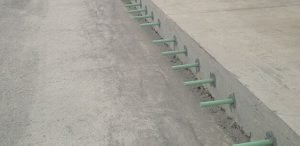What are Dowel Bars? its 4 Placement Steps, and Advantages
The dowel bars are small steel bars that are used to produce a mechanical connection between slabs without restricting horizontal joint movement and these bars are mainly used in the jointed plain concrete pavement to carry the additional stress and load included.

By allowing the leave slab to assume some of the load before the load is actually over it, they increase load transfer efficiency and this reduces joint deflection and stress in the leave slabs and approach.
In general dowel bars are used in the concrete pavements and are round steel bars. To transfer the load of producing in the concrete slab or pavement, dowel bars are left to joint any slab, column, and pavement. The range of dowel bar length will be 45d to 50d as d is the dia of the bar.
Size of Dowel Bars:
On the thickness of the pavement the size of dowel bar depends and mostly dowel bars are 18 inches long, 1.25 to 1.5 inch in diameter, and spaced 12 inches.
The dowel bars are either stainless steel or epoxy coated to protect the bars from corrosion.
Purposes of Dowel Bars:
There are the following purposes of dowel bars such as;
- Dowel bars are used to transfer the load from one slab to its adjacent slab and two consecutive slabs move together which reduces the impact loading developed by the slab.
- These bars are used to reduce corner cracking and joint faulting.
- These bars are used to improve the performance of pavement joints.
Placement of Dowel Bars:
There are following steps in the placement of these bars such as;
- These bars must always be parallel to the centerline.
- At least one-half of the dowel can be on each side of the joint or crack and a new channel must be cut for this.
- To allow movements, these bars are placed across transverse joints of concrete pavement.
- To restrict bonding to PCC, they are inserted at the mid-depth of the slab and coated a bond making material. Then the dowel helps to transfer loads allowing expansion and contraction of adjacent slabs.

In new pavement construction, the conventional approach to dowel bar placement is to place 11 bars for a 12-foot lane starting with the first bar located 12 inches from the pavement edge, and apart from the next adjacent bar all of the bars placed 12 inches. This is modified to place three or four dowel bars in each wheel path for a dowel bar retrofit.
For slabs and columns, these bars are also used in RCC wall in two ways such as;
Method 1; Before pouring concrete in a position short length bars are placed and in terms of bonding, it is the most common and successful method. As for bonding purposes, it does not require chemical so it is cost-effective.
Method 2; In this method for strong bonding, the holes are drilled in the concrete and filled with Hilti Chemical but this method is expensive because of the use of Hilti Chemical. When we forget to place extensions bars before concreting then this method is adopted.
Installation Problems:
- Due to poorly adjusted equipment, damage dowel baskets, and improper basket anchoring bars are missing or misplaced.
- The concrete around the bars is too stiff mixed or poorly compacted.
Advantages of Dowel Bars:
There are the following advantages of dowel bars such as;
- These bars reduces stresses and deflection.
- The load-carrying capacity of the slabs is increased by these bars.
- The initial pavement life also increases by these bars.

